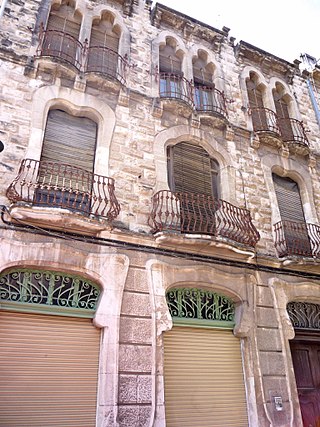
Alicante is a province of eastern Spain, in the southern part of the Valencian Community. It is the second most populated Valencian province. Likewise, the second and third biggest cities in the Valencian Community are located in this province.

The City of Arts and Sciences is a cultural and architectural complex in the city of Valencia, Spain. It is the most important modern tourist destination in the city of Valencia and one of the 12 Treasures of Spain.

Ronda is a town in the Spanish province of Málaga. It is located about 105 km (65 mi) west of the city of Málaga, within the autonomous community of Andalusia. Its population is about 35,000. Ronda is known for its cliffside location and a deep canyon that carries the Guadalquivir River and divides the town. It is one of the towns and villages that is included in the Sierra de las Nieves National Park.

Moros y Cristianos or Moros i Cristians literally in English Moors and Christians, is a set of festival activities which are celebrated in many towns and cities of Spain, mainly in the southern Valencian Community. According to popular tradition the festivals commemorate the battles, combats and fights between Moors and Christians during the period known as Reconquista. There are also festivals of Moros y Cristianos in Spanish America.

Martín Peña Bridge, in Spanish properly known as Puente Martín Peña, is an Art Deco style bridge from 1939, designed by Cecilio Delgado and others. It crosses the Martín Peña Channel in San Juan, Puerto Rico.

El Puento Nuevo or Puente de Hierro is a parabolic metallic bridge spanning the Segura River, completed in 1903 and located in the city of Murcia. As the second bridge built in the city across the river, was called New Bridge to distinguish it from the old bridge, even though today it is the second oldest of the city.

Alcoy is an industrial and university city, region and municipality located in the Valencian Community, Spain. The Serpis river crosses the municipal boundary of Alcoy. The local authority reported a population of 61,135 residents in 2018.

The architecture of Madrid has preserved the look and feel of many of its historic neighbourhoods and streets, even though Madrid possesses a modern infrastructure. Its landmarks include the Royal Palace of Madrid, the Royal Theatre with its restored 1850 Opera House, the Buen Retiro Park, the 19th-century National Library building containing some of Spain's historical archives, a large number of national museums, and the Golden Triangle of Art located along the Paseo del Prado and comprising three art museums: Prado Museum, the Reina Sofía Museum, and the Thyssen-Bornemisza Museum, which completes the shortcomings of the other two museums. Cibeles Palace and Fountain have become the monument symbol of the city.

The Moors and Christians of Alcoy is a popular festival which takes place in the city of Alcoy in the Spanish Province of Alicante, including the representation of a historic conflict between Muslims and Christians.

Vicente Juan Pascual Pastor was a spanish architect, one of the main architects of the Art Nouveau in Alcoy and the Valencian Art Nouveau.

Art Nouveau in Alcoy,, as one of the main focuses of the Valencian Art Nouveau, is the historiographic denomination given to an art and literature movement associated with the Art Nouveau in Alcoy (Alicante), Valencian Community, in Spain.

Valencian Art Nouveau, is the historiographic denomination given to an art and literature movement associated with the Art Nouveau in the Valencian Community, in Spain.

The Casa del Pavo is a private building at 15 Sant Nicolau Street, in the city center of Alcoy (Alicante), Valencian Community, Spain. It is one of the main works of the Art Nouveau in Alcoy.

The Circulo Industrial de Alcoy(Alcoy's Industrial Circle) is a cultural institution from Alcoy (Alicante), Valencian Community, Spain, founded on January 1, 1868. It is placed at 19 Sant Nicolau street, in the city center of Alcoy.

The Casa Laporta(Laporta house) is a private building at 26 País Valencià avenue, in the city center of Alcoy (Alicante), Valencian Community, Spain. It is one of the main works of the Art Nouveau in Alcoy.

The Casa d'Escaló(Escaló house) is a public building at 2 Joan Cantó street, in the city center of Alcoy (Alicante), Valencian Community, Spain. It is one of the main works of the Art Nouveau in Alcoy.

The Cementerio de San Antonio Abad(transl. Saint Anthony Cemetery) or Cementeri d'Alcoi is a cemetery located in Alcoy (Alicante), Spain.

The Casa Vilaplana(Vilaplana house) is a private building at 8 Joan Cantó street in the city center of Alcoy (Alicante), Valencian Community, Spain.

The Casa Briet(Briet house) is a private building at 24 Sant Josep Street, in the city center of Alcoy (Alicante), Valencian Community, Spain.

San Patricio bridge is a bridge which supports the Tempul aqueduct as it passes over the River Guadalete, near the town of La Barca de la Florida, in the municipality of Jerez de la Frontera in Spain. Designed in 1925 by the engineer Eduardo Torroja and built under the direction of the engineer Francisco Ruiz Martínez, is considered one of the first exponents of the use of prestressed concrete in Spain. At the time of its construction it became the cable-stayed bridge with the largest span in the world, with 57 metres.




















